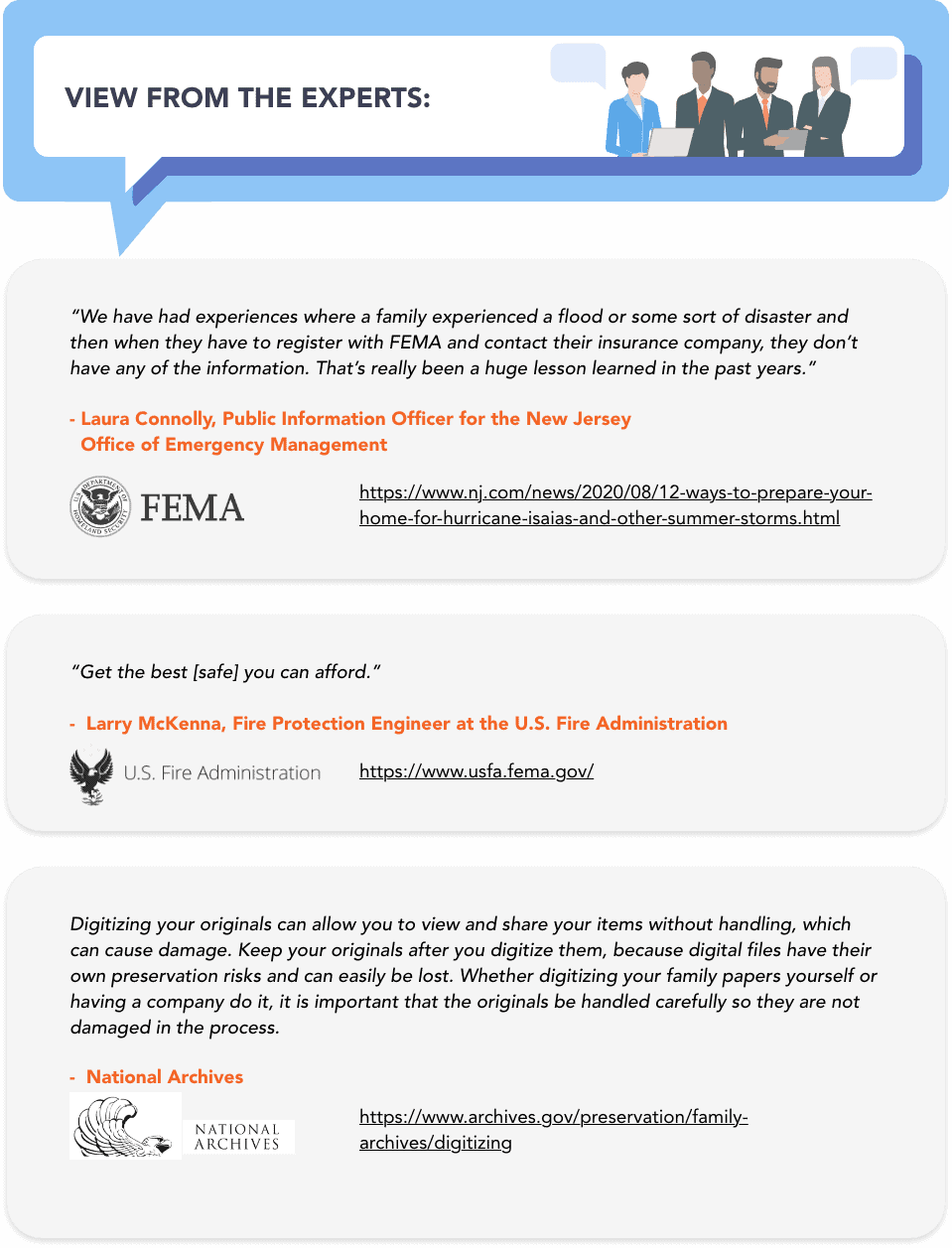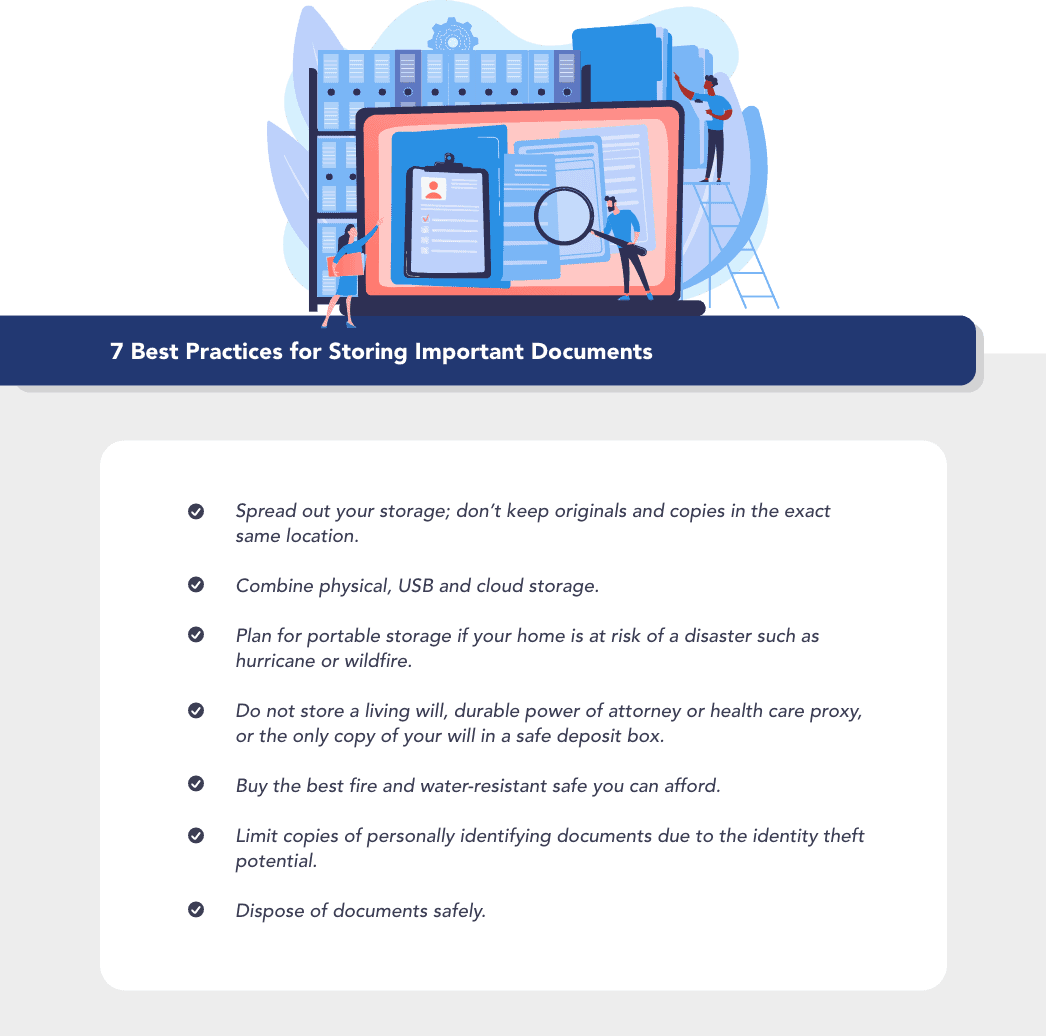

Life goes a lot easier if you keep important documents such as your passport, birth certificate, and vaccination records handy, but there isn’t one “right” way to store them. You know your needs and life circumstances best, so use the “whys” of storage to inform the “how.” Examples of whys could be:
The best practices mix physical storage (a safe, safe deposit box, etc.), the cloud, and a thumb drive/external hard drive. This guide explains which documents to keep and takes you through the various storage options.
 Table of Contents
Table of Contents
 Documents to Keep
Documents to KeepThe major documents for your family to keep, especially if you are fleeing a disaster, include these:

Some can be digitized, but retain your original birth certificate or a certified copy. Really, go original with any document verifying your identity (passport, driver’s license, military ID, Social Security card, etc.). Original documents also help prove your legal status or relationship to another person (adoption papers, child custody papers, etc.).
If you have pets, include their vaccination/medical records, ID chip numbers, and updated pictures.
Otherwise, the important documents to keep fall into six categories. The specific number increases or decreases a bit, depending on who you ask.

The “Medical” and “Estate Planning” categories have overlap potential. That’s OK. The main thing is to make your estate planning documents accessible to the right people.
Many of these are already digital, which lessens the amount of physical paperwork to deal with.
In some situations, you’re fine keeping just the previous year’s documentation, for example, one year’s worth of pay stubs, canceled checks, and monthly retirement/investment statements. Once you get your yearly investment summary, dispose of the monthly statements. Keep yearly statements for as long as you have the account plus seven years.

Don’t put all of your eggs (originals and copies) in one basket. Otherwise, you risk losing everything at once.
Scenario: John uses a thumb drive to make copies of important documents. He keeps the originals and the thumb drive in his fire-resistant, water-resistant home safe.
Problem: An especially bad fire destroys the contents of the safe. John loses his originals and the copies.
Two alternatives: Cloud storage in addition to thumb drive storage; storing the thumb drive in a separate location such as a bank safe deposit box
Do proceed carefully if you make (or obtain) copies of personally identifying documents such as your birth certificate and Social Security card.
Pro Tip: Speaking of identity theft, it’s important to protect yourself from identity theft by using one of the top-rated identity theft protection services. Check out LifeLock or Aura, two of our favorite providers. As they say, an ounce of prevention is worth a pound of cure!
 Physical Storage
Physical StorageHere’s a look at the various options for physical storage. They include fire-resistant safes, safety deposit boxes, and filing cabinets.

Good, all-around storage solution
As Nick Guy with Wirecutter explains, “Document safes are meant to provide protection from fire, water, and to a degree, theft, for people who wish to keep important belongings safe in an office or at home. They’re best for important documents—such as passports or birth certificates—or small items like hard drives or USB sticks. Most people can find good use for a fireproof safe, whether they want to be ready for travel or major financial transactions or just want to add an extra layer of safety for a drive full of treasured photos.” 4
Going further, Larry McKenna with the U.S. Fire Administration advises, “Get the best [safe] you can afford.”
You have a few options to take document protection one step further. One is to use plastic page slips to safeguard against wear and tear, liquid spills, or sunlight (mostly for when the documents are outside of the safe). You can even put these documents in a three-ring binder for quicker escape in case of a disaster—more on this soon.
Another option is to keep the documents in fire- and water-resistant bags inside the safe. The bags themselves offer fire and water protection but not as much as a safe. Still, when combined, they provide another layer of defense. They’re also easy to grab for a quick exit before a disaster hits.
If you drive often with documents in the vehicle; when there’s a high chance of upcoming emergencies or disasters; when combined with a safe or safety deposit box as another layer of defense against fire and water
We already touched on fire- and water-resistant bags so won’t repeat much. It does bear saying that banks transporting cash and sensitive documents put them in these types of bags. Otherwise, the goodies could go up in flames if a fiery crash occurs.
Fire-resistant bags do not offer the same level of protection that fire-resistant safes do, so combine them with another storage method when possible.
Some of the bags are pretty small, while others are larger. One of the larger bags (BLOKKD brand) offers fire resistance for 30 minutes up to 1,300 °F and features locking zippers to keep children out. 5

Portability during emergencies or disasters
Binders are easy to include in grab-and-go bags (also called go-bags or bug-out bags). If your area is likely to be evacuated soon for, say, a hurricane, fire or earthquake, insert your most important documents into the binder sleeves. They’re ready to go in a hurry.
Don’t feel comfortable keeping documents in a go-bag? Combine the binder with a safe for easy transfer to a go-bag.
Could be one part of an overall storage strategy; if you have no concerns about paying rent on time; if home security or disasters are an issue

Unfortunately, safe deposit boxes aren’t as safe as you might think. In fact, Jerry Pluard, the president of a Chicago company that insures safe deposit boxes, estimates that about 33,000 boxes a year are harmed by accidents, natural disasters, and thefts. 6
That said, the odds of your items staying intact are in your favor. (Remember to pay your rent on time!) Safety deposit boxes remain a relatively good bet for storing many types of important documents, including these:
Use a home safe or another accessible storage method for passports. Do this even if you don’t travel out of the country frequently. Why forego a spur-of-the-moment trip just because of banking hours?
Safe deposit boxes don’t offer 100% protection in the eventuality of a massive flood, so put your documents in water-resistant bags (also called fire-resistant bags) or zippered plastic bags. If you also store jewelry and high-value items, be aware that FDIC insurance doesn’t apply. Get homeowners insurance or a policy rider to cover these items.
Tell your attorney and/or heirs about the safe deposit box so they know to access it in case of your death. Fortunately, you can have a cosigner with the same powers you retain, but the general lack of access is why you shouldn’t store a living will, durable power of attorney or health care proxy, or your original will in a safe deposit box. These documents are of little use if no one can get to them.

Good for many types of financial and legal documents
Physical filing systems act as another layer in document storage, especially for financial and legal documents. They offer more space and organization, but in the long term, you may prefer an external hard drive and/or the cloud. There’s less chance of theft and a lesser amount of physical paperwork to keep around.
However, if something is tax-related, keep the originals whenever possible (it’s fine to make copies). For instance, original gas receipts are more authoritative than digital photos of the receipts.
Many filing cabinets are not fire- and water-resistant. Some are, though—you just have to make a point to buy them. (Don’t expect the first filing cabinet you see at your local office supply store to be fire-resistant.) Check the UL rating and the ETL Electronic Media rating.
Proceed with Caution if Using These Solutions
The following solutions are not necessarily best practices, but they’re common enough. In some situations, they even make perfect sense. Just know what you’re potentially getting into.

Thanks to the advent of home safes, it’s less common these days to have your lawyer store your estate planning paperwork, original will, and other legal documents. Firms such as Gudorf Law in Ohio recommend that clients use a home safe or fire-resistant box to store these documents. The firm does scan and make copies that are accessible via the online client portal. 7
A major downside to storing documents at your lawyer’s office: They could fall through the cracks if your lawyer (or even someone else in the practice) retires, dies, or otherwise leaves.
However, you may have reasons to store the papers at your lawyer’s office. Perhaps you don’t trust your family, or your house has been broken into multiple times. Talk with your lawyer about how the documents will be stored and if there’s a written policy on retention and disposal. Remember to tell your executor where the will is stored.
Some states such as Ohio allow you to keep your original will (and trust documents) at the office of the probate court judge.
Some fake books are hollow, with no locking mechanism. Others have locks and somewhat double as safes. Either type lets you store important documents in plain sight, whether the fake book is in your bedroom, office, or college dorm room.
Fake books are extremely portable but don’t expect them to protect your documents in a fire or flood. Burglars can spot them easily enough, too.

Many non-portable safes such as wall safes, hidden safes, and anchored safes offer fire and water resistance but double-check the safe’s UL rating. You want a minimum of 30 minutes’ protection in a fire up to 1,550 °F.
Now, there’s nothing wrong with non-portable safes, per se. They’re just not necessary if you’re looking for a document storage solution. Go portable for more versatility and less hassle.
Another thing: Many non-portable safes can be carried out of your home by determined burglars. They’re not as secure as you might think. Try to store your documents separately from high-value items.
Self-storage may make sense if you have a large number of business documents or family photos and documents. Find a climate-controlled unit, and make backup digital copies of anything you don’t want to lose.

 Electronic Storage
Electronic StorageElectronic document storage means portability and accessibility. For example, you can make multiple copies of important documents to access from anywhere (and decrease the amount of paper you keep around).
OK in the short term during emergencies or disasters; OK for family photos and other documents that don’t require security
Email is perhaps the simplest method of electronic storage but isn’t too secure. Scan a document or take a picture of it and email the file to yourself. 8
Make sure the photo files are clear.
Secure your devices and email account. Anyone who gets into your account could potentially have access to your driver’s license number, Social Security number, and other information.
Try not to use email for long-term document storage. There are too many ways it could go wrong, but email does come in handy during emergencies. Set strong, unique locks/passwords, and feel free to use a password manager.
Good as one part of an overall storage strategy; reducing the amount of paper; during emergencies or disasters
Thumb drives and external hard drives reduce paper clutter and don’t require that you email important documents to yourself. Just scan a document and save it to the drive (or save it from a website to the drive).
Store your drives separately from document originals, especially if you don’t use cloud storage. Otherwise, you risk losing everything in case of fire or theft.
OK for emergencies or disasters
Device storage is arguably the simplest digital solution of them all, maybe beating even email. Use your phone or tablet to take a photo of a document and keep the copy right on the device.
This method may be necessary during disasters, but don’t use it as a long-term solution. It’s easy enough for your files and photos to fall into the wrong hands via theft, loss, hacking or even just a nosy acquaintance. At all times, secure your smartphone the best you can.
Device storage is not as risky when the device in question is your computer that stays put. It never goes out; it never leaves home. A hard drive crash could still destroy your documents, though. Either way, password protect your folders and use encryption software to safeguard against malware.

OK for some important or sentimental documents; reducing the amount of paper
First things first: Don’t use cloud storage to keep digital copies of your birth certificate, Social Security card and other identifying information. (If you must have digital copies, go with thumb drives or external hard drives.)
That said, cloud storage is a smart solution for many document types, especially if you run a business. You reduce the amount of paper kept around and can access cloud files from anywhere as long as you have an internet connection. Fire, water, theft and the like are less of a concern but take the appropriate cybersecurity protocols.
Cloud storage is a good choice for documents that are important because they’re sentimental. For instance, you might have too many old newspaper clippings, grade school certificates, and family photos to keep in your home. A common option is to use a mobile scanning app for scanning and uploading to the cloud (plus an external hard drive). Put the physical originals in storage, give them to someone who wants them or even dispose of them. 9
 Disposing of Important Documents
Disposing of Important DocumentsGood document storage includes good disposal. After all, any document sitting in a garbage can is at risk. Shred the documents you’re disposing of, be they ATM receipts, bank statements, copies of your birth certificate, credit card bills, legal paperwork, property transactions, medical records, password lists, or utility bills. If you don’t own a shredder (or even if you do), many communities hold document shred days at the same time as drug takeback days. Many office stores offer document shredding, too.
If you’re selling, giving away, recycling, or donating a computer, conduct a hard drive wipe. A factory reset isn’t quite secure enough.
Similarly, Apple support explains what to do before you give away, sell, or trade-in your device. You have several options for Android devices, too (read up on Google tips).
 Storing Important Documents
Storing Important DocumentsOrdinarily, you don’t get important documents all at once. Rather, they come in trickles, with one or two documents here and there over the years. You may also need to store your children’s (and spouse’s and pets’) documents. It’s easy to lose track of all these items and their locations. A master list outlining these locations helps, but be sure to store the list securely, too.
Best practices involve physical storage in addition to thumb drive/external hard drive storage and the cloud. You may need to keep your most important documents portable in case you leave home quickly.
 Additional Resources
Additional ResourcesHealth Paperwork: Action and Care Plans, Vital Records and More
 References and Footnotes
References and Footnotes